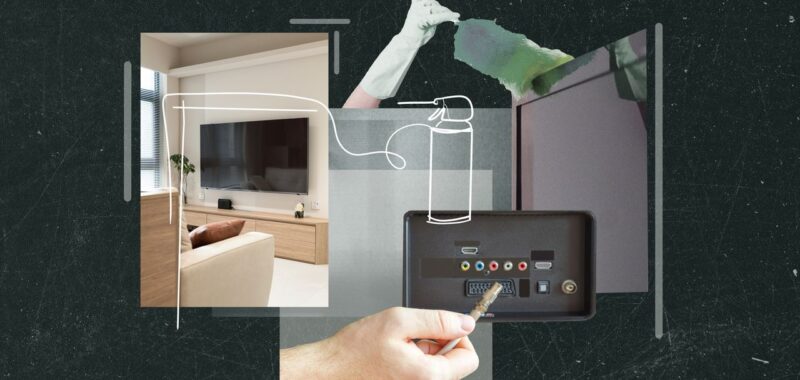Since it’s handled regularly, cleaning the remote is a must-do chore to prevent the spread of germs. This is the one time when harsh chemicals can be used sparingly. Follow the manufacturer owner’s manual instructions first, but if sanitizing is needed, use a cleaner that’s at least 70% alcohol, according to the Centers for Disease Control (CDC) recommendations. (Basic drugstore isopropyl alcohol works well for this.)
- Step 1: Remove the batteries from the remote control.
- Step 2: Dampen a clean microfiber cloth and rub gently on the top and the underside of the remote control. As with the TV screen recommendations, you’ll want to avoid spraying directly onto the surface, as this could cause the device to malfunction.
- Step 3: Use a cotton swab dipped in a small amount of the cleaning solution to reach and clean any gunk that’s jammed between the buttons.
- Step 4: Let it dry thoroughly before replacing the batteries and using it again.
What is the safest thing to clean a flat-screen TV with?
When figuring out how to clean a TV screen, selecting the safest cleaning solution is key, but it’s also important to know what cleaning products to avoid. Keep in mind that not only should you skip cleaning with certain products, you should also avoid spraying them in close proximity to the TV.
Both Panasonic and Samsung both have lengthy “avoid” lists that include harsh chemicals such as wax, cleaning fluid, acetone, benzene, alcohol, thinner, mosquito repellent and insect spray (really!), lubricant, solvent, and undiluted mild dish soap. These can, as Williams says, “cause clouding and can wear away your TV’s anti-glare coating.”
In terms of what to use, Samsung recommends “monitor cleaner only” (also called TV screen cleaner). Panasonic suggests “one part mild liquid dish soap diluted by 100 times the amount of water.” To make this cleaning solution, add a scant teaspoon of liquid dish soap to two cups of water, stirring well to dissolve.
Williams likes TV cleaning kits for their ease of use. “A TV kit will be your safest option for cleaning a TV,” he says. “These kits will come with everything you need to get your TV looking new, like screen-cleaning solvent and a fast-drying microfiber cloth.” You can find TV cleaning kits and cleaning products designed for flat-screen TVs at electronics stores or on Amazon.
Some people swear that only distilled water is useful as cleaning spray for their delicate electronics. Although Williams does not necessarily recommend using distilled water, if you know for a fact you have hard water in your area, you may want to try the distilled water route and see if you notice a difference. Hard water, which has high levels of calcium and magnesium, may leave a film or residue when it’s used for cleaning. Before you spray water to clean TV screens, try experimenting with tap water on a less-important screen, like an old cell phone, to assess the results.
Can I use Windex on my TV screen?
If you can picture the hulking tube TVs (also known as CRTVs) of yore, you may also remember how delightfully easy they were to clean—a few spritzes of window cleaner and some wipes with paper towels and you were good to go—no special microfiber cloth required. But modern TVs with fancier technologies like LCD, OLED, and plasma call for gentler techniques. “Avoid using chemicals like alcohol, ammonia or acetones when cleaning your TV. These cleaners were safe to use for previous generations of TVs with glass panels, but as the hardware changes with time, the cleaning methods do too,” says Williams. Since some multi-purpose and glass cleaners are made with ammonia, skip the Windex.
Can I use glasses cleaner on my TV screen?
While glasses cleaner is designed for delicate lenses, it’s not ideal for TV screens. Most glasses cleaners contain alcohol or ammonia, which can damage the anti-glare coating on modern TVs. Instead, opt for a TV screen cleaner (easily found in TV cleaning kits, mentioned above) or diluted mild dish soap (a scant teaspoon of liquid dish soap stirred into two cups of water) for stubborn smudges. If your glasses cleaner is specifically labeled “electronics safe,” it may be an acceptable option, but always check your TV manufacturer’s guidelines first to determine how to proceed safely.
How do you clean a smart TV screen?
Modern TVs are often smart TVs but the cleaning tips are the same as the ones for LCD, OLED and plasma TVs. The microfiber cloth is your TV screen’s best friend. “The majority of TVs you purchase today will be smart TVs, and the cleaning process is the same as TVs without smart capabilities,” Williams says.
How do I keep my TV screen clean?
Prevention is key to keeping your TV screen looking spotless. There are a number of ways to minimize buildup; dusting regularly, even just quickly wiping your screen weekly with a dry microfiber cloth, will prevent dust from accumulating. More generally, controlling the room’s dust levels by cleaning nearby furniture and carpets will help reduce airborne debris that may end up settling on your screen. Consistently dusting keeps your TV screen clean—and keeps complaints to a minimum during family movie nights. Avoid touching the screen, as fingerprints and smudges can appear quickly on the display. Additionally, avoid placing your TV near open windows or heating vents where dust and debris may gather more frequently. Lastly, for the extra-cautious (or for those with young children or pets), using a screen protector is a sure-fire way to safely shield your TV from pesky fingerprints and accidental scratches.

